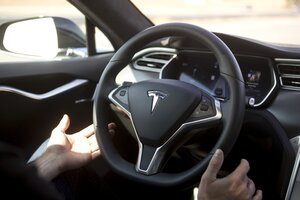Tesla Motors goes 'no hands’ with autopilot software
Tesla has released several key updates to its Model S and Model X vehicles that are essential building blocks to cars that drive fully autonomously.

New Autopilot features are demonstrated in a Tesla Model S during a Tesla event in Palo Alto, California October 14, 2015.
Beck Diefenbach/Reuters/File
Cars that function autonomously—that truly drive themselves—remain some years away; yet today, Tesla Motors [NSDQ: TSLA] released several key technologies that are essential building-block technologies for getting there.
With its latest software upgrade, called version 7.0, Tesla has added to Model S sedans and Model X utility wagons a feature suite that Tesla says “increases the driver’s confidence behind the wheel with features that help the car avoid hazards and reduce the driver’s workload.”
The update includes Autosteer, a feature that steers the vehicle to stay in the current travel lane, working with Traffic-Aware Cruise Control.
In short, it's no-hands cruise control. But the feature won’t quite allow you to drive while you’re doing other things; the driver still has to keep his or her hands on the steering wheel. Furthermore, CEO Elon Musk said that it’s considered a “public beta” feature.
Lane changes and parking automated, too
While the Model S may rival some of the most sophisticated lane-keep systems on the market—now actually in a wide range of luxury models—with Autosteer, it goes beyond that with a new Auto Lane Change feature that allows you to move to the adjacent lane when it’s safe to do so, merely by engaging the turn signal.
The Model S can now also park itself in a parallel spot. That feature is enabled at low speeds, with a ‘P’ on the instrument panel that appears when a spot is detected; once you respond to a screen prompt and see the rear camera display, the system actually controls both steering and vehicle speed.
And there’s an Automatic Emergency Steering and Side Collision Warning feature that alerting the driver to adjacent vehicles that are too close, and making slight steering adjustments.
Real-world 'beta' to prove itself?
The new suite of features uses lane markings as a primary means of following lanes, however it backs the inputs up with data from a high-resolution GPS database. So far Tesla hasn’t revealed much about how it’s gathered detail for that or what its limitations are, but Musk said that the feature is adaptive.
Tesla is rolling the update out to existing Model S and Model X vehicles over the next several days; it applies to all that have been built over the past year or so—which means that tens of thousands of vehicles will suddenly have hands-off-the-wheel cruise control. Stay tuned on what happens.

